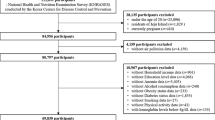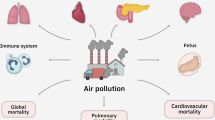Abstract
Air pollution is one of the biggest public health issues, and the eye is continuously exposed to multiple outdoor air pollution. However, to date, no large-scale study has assessed the relationship between air pollutants and cataracts. We investigated associations between outdoor air pollution and cataracts in the Korean population. A population-based cross-sectional study was performed using data from the Korea National Health and Nutrition Examination Survey, including 18,622 adults more than 40 years of age. The presence of cataracts and their subtypes were evaluated by ophthalmologists. Air pollution data (levels of particulate matter, ozone, nitrogen dioxide, and sulfur dioxide) for the 2 years prior to the ocular examinations were collected from national monitoring stations. The associations of multiple air pollutants with cataracts were assessed by multivariate logistic regression analyses. Sociodemographic factors and previously known risk factors for cataracts were controlled as covariates (model 1 included sociodemographic factors, sun exposure, and behavioral factors, while model 2 further included clinical factors). Higher ozone concentrations were protectively associated with overall cataract which included all subtypes [single pollutant model: 0.003 ppm increase—model 1 (OR 0.89, p = 0.014), model 2 (OR 0.87, p = 0.011); multi-pollutant model: 0.003 ppm increase—model 1 (OR 0.80, p = 0.002), model 2 (OR 0.87, p = 0.002)]. Especially, higher ozone concentrations showed deeply protective association with nuclear cataract subtype [0.003 ppm increase—single pollutant model: model 2 (OR 0.84, p = 0.006), multi-pollutant model: model 2 (OR 0.73, p < 0.001)]. Higher tropospheric ozone concentrations showed protective associations with overall cataract and nuclear cataract subtype in the Korean population.
Similar content being viewed by others
References
Almon S (1965) The distributed lag between capital appropriations and expenditures. Econometrica 33(1):178–196. https://doi.org/10.2307/1911894
Beebe DC, Holekamp NM, Shui YB (2010) Oxidative damage and the prevention of age-related cataracts. Ophthalmic Res 44(3):155–165. https://doi.org/10.1159/000316481
Chylack LT, Wolfe JK, Singer DM, Leske MC, Bullimore MA, Bailey IL, Friend J, McCarthy D, Wu S-Y (1993) The lens opacities classification system III. Arch Ophthalmol 111(6):831–836. https://doi.org/10.1001/archopht.1993.01090060119035
Dabass A, Talbott EO, Venkat A, Rager J, Marsh GM, Sharma RK, Holguin F (2016) Association of exposure to particulate matter (PM2.5) air pollution and biomarkers of cardiovascular disease risk in adult NHANES participants (2001-2008). Int J Hyg Environ Health 219(3):301–310. https://doi.org/10.1016/j.ijheh.2015.12.002
Hwang SH, Choi YH, Paik HJ, Wee WR, Kim MK, Kim DH (2016) Potential importance of ozone in the association between outdoor air pollution and dry eye disease in South Korea. JAMA Ophthalmol 134(5):503–510. https://doi.org/10.1001/jamaophthalmol.2016.0139
Kim Y, Myung W, Won HH, Shim S, Jeon HJ, Choi J, Carroll BJ, Kim DK (2015) Association between air pollution and suicide in South Korea: a nationwide study. PLoS One 10(2):e0117929. https://doi.org/10.1371/journal.pone.0117929
Klein BE, Klein R, Lee KE (1998) Incidence of age-related cataract: the Beaver Dam Eye Study. JAMA Ophthalmol 116:219–225
Korea Census Bureau (2015) Population and Housing Census 2015
Lee H, Kim EK, Kang SW, Kim JH, Hwang HJ, Kim TI (2013) Effects of ozone exposure on the ocular surface. Free Radic Biol Med 63:78–89. https://doi.org/10.1016/j.freeradbiomed.2013.05.006
Lim YH, Kim H, Kim JH, Bae S, Park HY, Hong YC (2012) Air pollution and symptoms of depression in elderly adults. Environ Health Perspect 120(7):1023–1028. https://doi.org/10.1289/ehp.1104100
Malhotra M, Majumdar DK (2001) Permeation through cornea. Indian J Exp Biol 39(1):11–24
Michael R, Barraquer RI, Willekens B, Jv M, Vrensen GFJM (2008) Could cortical cataracts be induced by accommodation forces? Invest Ophthalmol Vis Sci 49:3795–3795
Mohan M, Sperduto RD, Angra SK, Milton RC, Mathur RL, Underwood BA, Jaffery N, Pandya CB, Chhabra VK, Vajpayee RB et al (1989) India-US case-control study of age-related cataracts. India-US Case-Control Study Group. Arch Ophthalmol (Chicago Ill.: 1960) 107:670–676
Møller P, Loft S (2010) Oxidative damage to DNA and lipids as biomarkers of exposure to air pollution. Environ Health Perspect 118(8):1126–1136. https://doi.org/10.1289/ehp.0901725
Mustafa MG (1990) Biochemical basis of ozone toxicity. Free Radic Biol Med 9(3):245–265. https://doi.org/10.1016/0891-5849(90)90035-H
Nam G, Han K, Ha S, Han B, Kim D, Kim Y, Cho K, Park Y, Ko B (2015) Relationship between socioeconomic and lifestyle factors and cataracts in Koreans: the Korea National Health and nutrition examination Survey 2008–2011. Eye 29(7):913–920. https://doi.org/10.1038/eye.2015.66
Nita M, Grzybowski A (2016) The role of the reactive oxygen species and oxidative stress in the pathomechanism of the age-related ocular diseases and other pathologies of the anterior and posterior eye segments in adults. Oxidative Med Cell Longev. (12):1–23. https://doi.org/10.1155/2016/3164734
O’Neill CA, van der Vliet A, Eiserich JP, Last JA, Halliwell B, Cross CE (1995) Oxidative damage by ozone and nitrogen dioxide: synergistic toxicity in vivo but no evidence of synergistic oxidative damage in an extracellular fluid. Biochem Soc Symp 61:139–152. https://doi.org/10.1042/bss0610139
Park S, Lee E-H (2015) Association between metabolic syndrome and age-related cataract. Int J Ophthalmol 8:804
Pau H (2006) Cortical and subcapsular cataracts: significance of physical forces. Ophthalmologica 220(1):1–5. https://doi.org/10.1159/000089267
Phaniendra A, Jestadi DB, Periyasamy L (2015) Free radicals: properties, sources, targets, and their implication in various diseases. Indian J Clin Biochem 30(1):11–26. https://doi.org/10.1007/s12291-014-0446-0
Poljsak B, Fink R. The protective role of antioxidants in the defence against ROS/RNS-mediated environmental pollution. Oxidative Med Cell Longev. 2014;671539.
Rim THT, Kim M-h, Kim WC, Kim T-I, Kim EK (2014) Cataract subtype risk factors identified from the Korea National Health and Nutrition Examination survey 2008–2010. BMC Ophthalmol 14(1):4. https://doi.org/10.1186/1471-2415-14-4
Seah SK, Wong TY, Foster PJ, Ng TP, Johnson GJ (2002) Prevalence of lens opacity in Chinese residents of Singapore: the tanjong pagar survey. Ophthalmology 109(11):2058–2064. https://doi.org/10.1016/S0161-6420(02)01221-6
Seaton A, Godden D, MacNee W, Donaldson K (1995) Particulate air pollution and acute health effects. Lancet 345(8943):176–178. https://doi.org/10.1016/S0140-6736(95)90173-6
Shalini VK, Luthra M, Srinivas L, Rao SH, Basti S, Reddy M, Balasubramanian D (1994) Oxidative damage to the eye lens caused by cigarette smoke and fuel smoke condensates. Indian J Biochem Biophys 31(4):261–266
Thylefors B, Negrel AD, Pararajasegaram R, Dadzie KY (1995) Global data on blindness. Bull World Health Organ 73(1):115–121
Torricelli AA, Novaes P, Matsuda M, Braga A, Saldiva PH, Alves MR, Monteiro ML (2013) Correlation between signs and symptoms of ocular surface dysfunction and tear osmolarity with ambient levels of air pollution in a large metropolitan area. Cornea 32(4):e11–e15. https://doi.org/10.1097/ICO.0b013e31825e845d
Truscott RJ (2005) Age-related nuclear cataract-oxidation is the key. Exp Eye Res 80(5):709–725. https://doi.org/10.1016/j.exer.2004.12.007
Voter KZ, Whitin JC, Torres A, Morrow PE, Cox C, Tsai Y, Utell MJ, Frampton MW (2001) Ozone exposure and the production of reactive oxygen species by bronchoalveolar cells in humans. Inhal Toxicol 13(6):465–483. https://doi.org/10.1080/08958370151131837
Welty LJ, Peng RD, Zeger SL, Dominici F (2009) Bayesian distributed lag models: estimating effects of particulate matter air pollution on daily mortality. Biometrics 65(1):282–291. https://doi.org/10.1111/j.1541-0420.2007.01039.x
World Health Organization (2006) WHO air quality guidelines for particulate matter, ozone, nitrogen dioxide and sulfur dioxide: global update 2005: summary of risk assessment
Wu R, Wang JJ, Mitchell P, Lamoureux EL, Zheng Y, Rochtchina E, Tan AG, Wong TY (2010) Smoking, socioeconomic factors, and age-related cataract: the Singapore Malay Eye study. Arch Ophthalmol (Chicago, Ill.: 1960) 128:1029–1035
Xu L, Cui T, Zhang S, Sun B, Zheng Y, Hu A, Li J, Ma K, Jonas JB (2006) Prevalence and risk factors of lens opacities in urban and rural Chinese in Beijing. Ophthalmology 113(5):747–755. https://doi.org/10.1016/j.ophtha.2006.01.026
Acknowledgements
We thank the Epidemiologic Survey Committee of the Korean Ophthalmologic Society. The Epidemiologic Survey Committee of the Korean Ophthalmologic Society mainly participated in making and processing KNHANES data about ophthalmologic questionnaire and examinations, and helped us to access KNHANES data. We also thank Min-Jae Ju for help in accessing the Korea Census Bureau.
Financial support
This work was supported by the Gachon University Gil Medical Center (Grant number GCU-2016-5202).
Author information
Authors and Affiliations
Corresponding author
Ethics declarations
This study was approved by the Institutional Review Board of the Korea Centers for Disease Control and Prevention and complied with the tenets of the Declaration of Helsinki.
Conflict of interest
The authors declare that they have no conflict of interest.
Additional information
Responsible editor: Philippe Garrigues
Electronic supplementary material
Figure S1
Flow diagram presenting the selection of study participants. (GIF 38 kb)
High resolution image
(TIFF 219 kb)
Figure S2
Yearly changes of multiple air pollution factors between 2006 and 2012 in South Korea. PM10 (μg/m3), O3, NO2, and SO2 (ppm) (GIF 13 kb)
High resolution image
(TIFF 304 kb)
Figure S3
Distributed lag models between outdoor air pollutants (particulate matter, ozone, nitrogen dioxide, and sulfur dioxide) and cataracts: a) model 1, b) model 2. (multi-pollutant model). PM: particulate matter; O3: ozone, NO2: nitrogen dioxide; SO2: sulfur dioxide. Model 1: sociodemographic factors, sun exposure, and behavioral factors (age, sex, region of residence, education level, income level, sun exposure, smoking, and alcohol drinking), were included as covariates. Model 2: Aforementioned factors and clinical factors (age, sex, region of residence, education level, income level, smoking, alcohol drinking, hypertension, diabetes mellitus, hypercholesterolemia, myopia, and obesity), were included as covariates. *: Associated with cataract in multivariate logistic regression after controlling with Bonferroni’s correction (each p < 0.017) (GIF 1216 kb)
High resolution image
(TIFF 745 kb)
Figure S4
Distributed lag models between ozone, nitrogen dioxide levels and nuclear cataracts in models 1 and 2: a) ozone, b) nitrogen dioxide. (multi-pollutant model). O3: ozone; NO2: nitrogen dioxide. Model 1: sociodemographic factors, sun exposure, and behavioral factors (age, sex, region of residence, education level, income level, sun exposure, smoking, and alcohol drinking), were included as covariates. Model 2: Aforementioned factors and clinical factors (age, sex, region of residence, education level, income level, smoking, alcohol drinking, hypertension, diabetes mellitus, hypercholesterolemia, myopia, and obesity), were included as covariates. *: Associated with cataract in multivariate logistic regression after controlling with Bonferroni’s correction (each p < 0.017) (GIF 679 kb)
High resolution image
(TIFF 456 kb)
Table S1
(DOCX 17 kb)
Rights and permissions
About this article
Cite this article
Choi, YH., Park, S.J., Paik, H.J. et al. Unexpected potential protective associations between outdoor air pollution and cataracts. Environ Sci Pollut Res 25, 10636–10643 (2018). https://doi.org/10.1007/s11356-018-1266-1
Received:
Accepted:
Published:
Issue Date:
DOI: https://doi.org/10.1007/s11356-018-1266-1




